Exclusive Gilded Age Arts Society Debuts New Public Exhibits in NYC
The American Academy of Arts and Letters, a venerable New York cultural institution, is a portal to art across time!

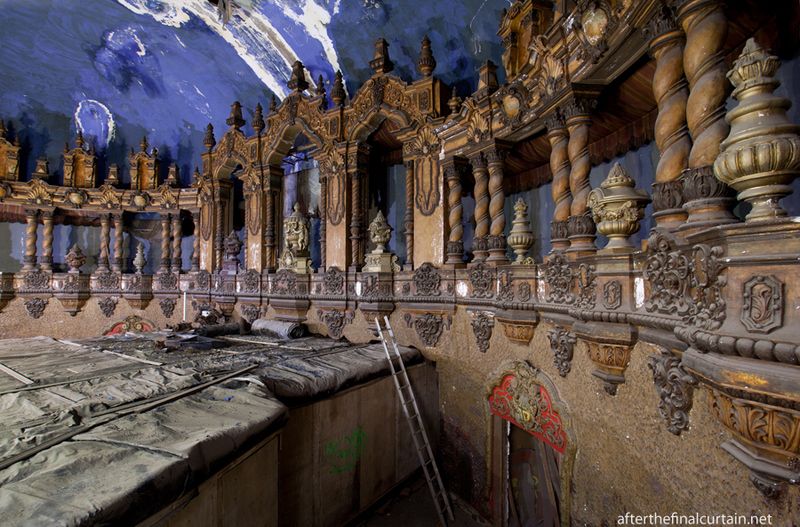
Inside the RKO Keith Theater. Image from After The Final Curtain
Once upon a time, opulent theaters built for the masses and the elite alike were the main destinations for entertainment. The theaters showed more than movies – it would be an all-day entertainment extravaganza from live music, dance performances, vaudeville, comedy to films. As we wrote in a previous exploration of the Loews Wonder Theatres, the most grand of them all in the New York City area, “in an era before television and with radio just a novelty, Americans could spend upwards of five hours or more in these theaters.”
Many theaters in New York City and New Jersey began as live performance theaters, and when vaudeville was on the decline, conversion into movie theaters became a more profitable option. But maintaining these grand film palaces was expensive and proved difficult to keep operational.
We bring you now 10 movie theaters in the New York City area that have stood abandoned for decades, falling into disarray as they became nothing more than warehouse spaces and retail store fronts.
 The main floor of the auditorium is now used as storage for a furniture store.
The main floor of the auditorium is now used as storage for a furniture store.
Located in Borough Park, Brooklyn, the Loew’s 46th St. Theatre was a movie palace that went through a few different cycles in its life from 1927 to 1973. It opened as the Universal Theater on October 9, 1927 to a huge, disorderly crowd of 25,000 people waiting for a spot in the 3,000-seat theater. Many even resorted to sitting on the fire escapes just to get a look at the beautiful interior.
Designed by renowned theater architect John Eberson, it was New York’s first “atmospheric theater.” Eberson’s design tried to emulate a starry, night sky over an Italian garden. Decorated with painted gold and a blue dome, the theater felt like an open-air auditorium with twinkling stars and other “atmospheric effects” being projected onto it. The rise of multiplex cinema in the ’60s caused the theater to fall into hard times and became a music venue, briefly becoming known as the “Brooklyn Rock Palace” where acts like the Grateful Dead, Jefferson Airplane, and the Byrds performed.
The theater has been closed since 1973, following community pressure regarding noise levels. The year after, it was sold to a furniture company whereupon significant changes were made on the interior, including the removal of the stage. The auditorium became a storage area for the furniture business, while the lobby became a show room.
Hidden in the East Village above a bodega on Avenue A between 6th and 7th Street sat the Hollywood Theatre. It opened in 1926 and was operated by RKO before Loew’s Inc. got a hold of it. Unfortunately, the old Hollywood did not last very long, shutting down in 1959. Afterwards, much of the orchestra and lobby areas were converted into retail space for East Village Farms, a health store. According to the Huffington Post, the bodega used much of it as a functional store room.
According to Cinema Treasures, much of the exterior survived, including the fire escape. Some of the interior decorations were saved because of a false ceiling in the bodega beneath it. Unfortunately, this little gem was demolished in the spring of 2015, but not before some photos were taken.
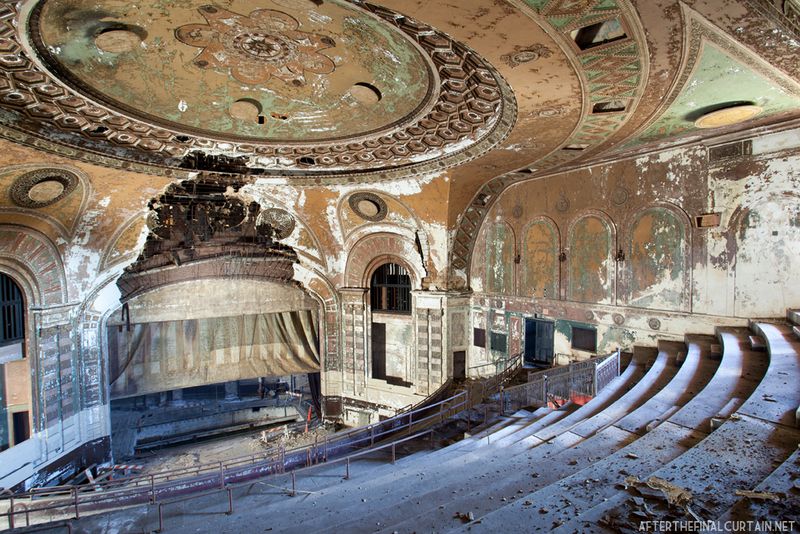
Image via After The Final Curtain
Coney Island‘s Shore Theatre opened on June 17, 1926 as the Loew’s Coney Island Theatre as both a vaudeville house and movie theater. Eventually the vaudeville was phased out and was strictly a movie theater. The 2, 387-seat theatre was constructed by the same company that demolished the Roxy Theatre in Manhattan, the Chainin Construction Company.
In 1964, it was taken over by Brandt Theatres and subsequently renamed The Shore. In the 1970s, the Shore switched gears and began to cater to its adult audience by showing X-rated films, though that didn’t last long as since it shut down in March 1973. The theater’s exterior facade was landmarked on December 14, 2010, but the interior was not landmarked, leaving it a possible victim of demolition.
This past January, developer Pye Properties bought the theater and said they will convert the Shore back into its former glory, reopening it as a year-round theater.
On our next tour of the Secrets of Coney Island, we’ll be making a stop outside the Shore Theatre.
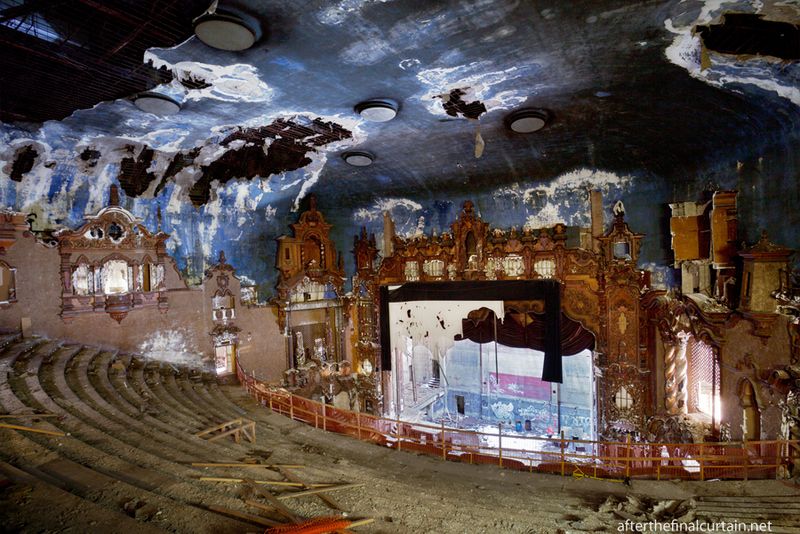
Image via After The Final Curtain
Originally called the Keith-Albee Theatre, the RKO Keith’s Theatre opened on December 25, 1928 at 1:00 pm in Flushing, Queens. The 2,974-seat theater was designed by Thomas W. Lamb in the Spanish Baroque Revival style. Lamb was a notable theater architect who designed others around the city like the Ziegfeld and United Palace Theatres. Similar to the Loew’s 46th St. Theatre, the Keith had a ceiling painted with the atmospheric effect as a clouded, night sky. The first film it showed was a silent film starring Clara Bow, a star of the Roaring Twenties.
The Keith-Albee-Orpheum Corporation that owned the theater was acquired by the Radio Corporation of America in 1929 to become RKO Pictures. Thus, the Keith-Albee was renamed RKO Keith’s Theatre. In 1980, Keith’s lobby was landmarked in 1984, and in 1986 was sold to a developer who closed it down only a few months later for demolition.
The Flushing community was outraged that such a historic building would be torn down only to become a strip mall. Ultimately, the community prevailed and stopped the demolition in February 1987. Since then however, the Keith’s been in a state of complete disrepair. The active Facebook group, Save the Flushing RKO Keith Theater has nearly 1900 members.
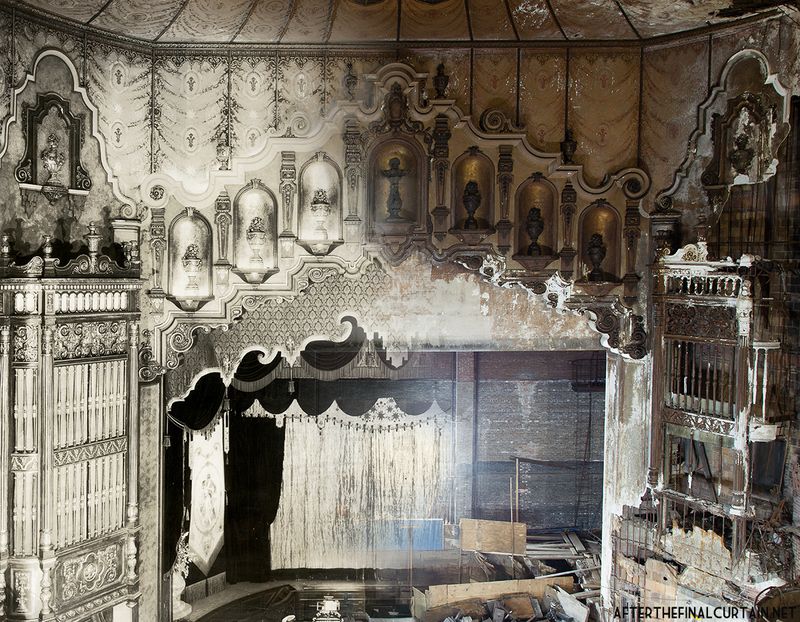
Image via After The Final Curtain
The Loew’s Canal Theatre at 31 Canal Street was built in 1927 and has been closed since the 1950s. When it opened, it was the second largest theater in New York City with 2,314 seats. Loew’s sold it to Greater M&S Circuit, but it didn’t survive long as it went bankrupt in 1929, and was bought back by Loew’s the same year. The Canal was designed by Thomas Lamb, who did many of the forgotten theaters of Upper Broadway, and showed mostly “B” movies and serials.
On September 10, 1932, both the Canal and the 46th St Theatres were rocked by explosions set off by bombs. The attack was believed to be connected to the Motion Pictures Operators’ Union Local 306 who were on strike at the time. The theater recovered with minimal damage, but after closing in the 1950s, the lobby was converted into a retail space with the auditorium as warehouse space
The Canal Theatre has been abandoned since the early 2000s, as the last tenant was a small appliance store and repair shop. Despite some fundraising movements to revitalize the space, nothing has come to fruition and the auditorium continues to be a warehouse. The terra cotta facade was landmarked by the Landmarks reservation Commission in 2010.
In February 2015, a group of graffiti artists broke into the abandoned theatre not to deface it, but to decorate it and “restore its former glory.” Artists 2ESASE of art collective UR New York and artists SKI created Art-Deco inspired posters that featured figures from the 1920s, and hung them throughout the building serving as a little reminder of what it was like in its heyday.
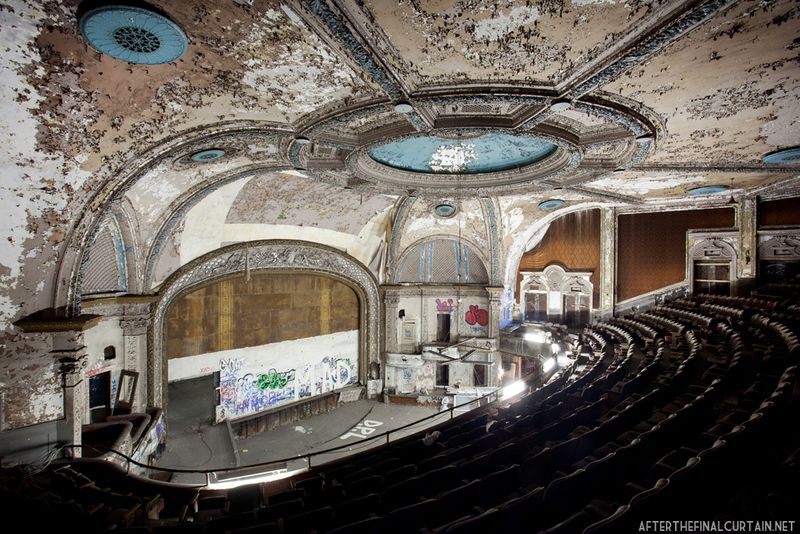
Image via After The Final Curtain
Located in Manhattan’s Hamilton Heights, the Moss and Brill’s Hamilton Theatre (later renamed the RKO Hamilton Theatre) was one of the first motion picture houses in New York. Opening in January 23, 1913 as a vaudeville house commissioned by vaudeville operator Benjamin Moss and Solomon Brill, the theater was designed by Lamb in the Renaissance Revival style. The Hamilton was sold in 1928 after Moss’s retirement and converted into a movie theater.
The Hamilton stopped showing films in 1958, partially closed, leaving the auditorium to operate as a sports arena and disco. In 1965 it was bought by a church which sold it in the mid-1990s. Like most of the theaters on this list, the front was converted into retail space, while the auditorium of this particular theater was used as the warehouse for a beer and liquor wholesaler.
The exterior of the Hamilton was landmarked in 2000, but the interior was making it susceptible to demolition. So far, there are no plans have been made to redevelop or demolish it.
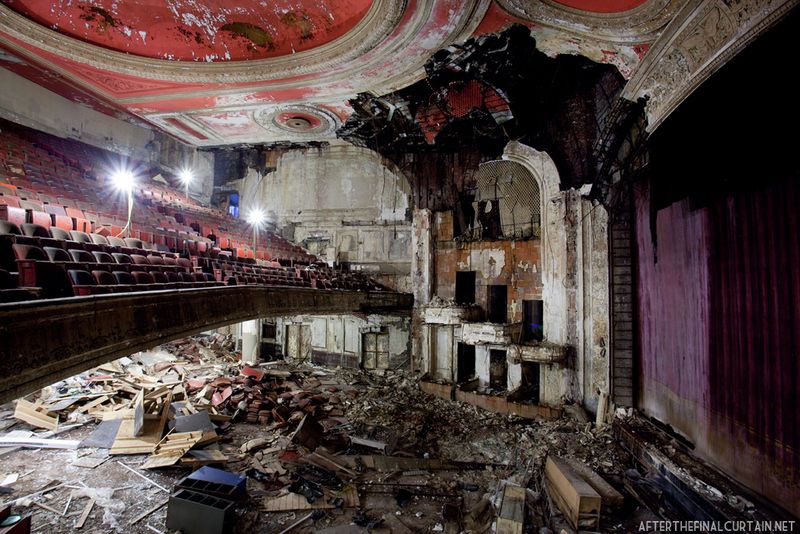
Image via After The Final Curtain
Venturing into New Jersey, the Paramount Theatre originally opened as the H.C. Miner’s Newark Theatre on October 11, 1886. A Brooklyn-based theater management company ran it as vaudeville house. In 1916, it was sold to Edward Spiegel who purchased the building next door as well to make the theater larger. Spiegel hired none other than Thomas Lamb to double the size of the lobby and renovate the auditorium..
In 1932, the owners struck a deal with Paramount-Publix (which would later become Paramount Pictures) who remodeled the vaudeville theater into a movie theater, renovating it once again. This time Lamb’s work was covered up with flat paint. It was after this deal that the H.C. Miner’s Newark was renamed The Paramount.
The Paramount closed due to increased insurance rates on March 31, 1986. Since then, the lobby has been used as an Army/Navy surplus store and other pop-up retail shops. There are current plans to renovate it into a multi-use entertainment complex that would demolish the whole auditorium, leaving only the original facade.
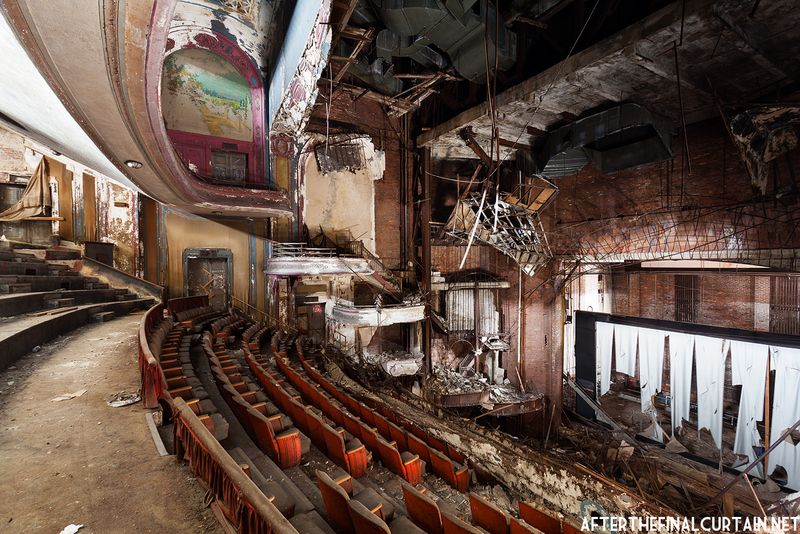
Image via After The Final Curtain
The Proctor Palace Theatre, designed by John W. Merrow, opened in downtown Newark on November 22, 1915. It was one of the rare “double decker” theaters with a large 2,300-seat theatre at the ground level, with an additional 900 seats on the top four floors beneath the roof. It had its beginnings as a vaudeville house before switching into a movie theater.
In 1929, owner F.F. Proctor sold the Palace to RKO, who changed the name to RKO Proctor’s Theatre. After this switch, the roof section was hardly used until the early 1960s when it reopened as a the Penthouse Cinema, showing mainly foreign films. After a merger with Stanley-Warner in 1968, the RKO Proctor closed because of new management and the infamous Newark riots.
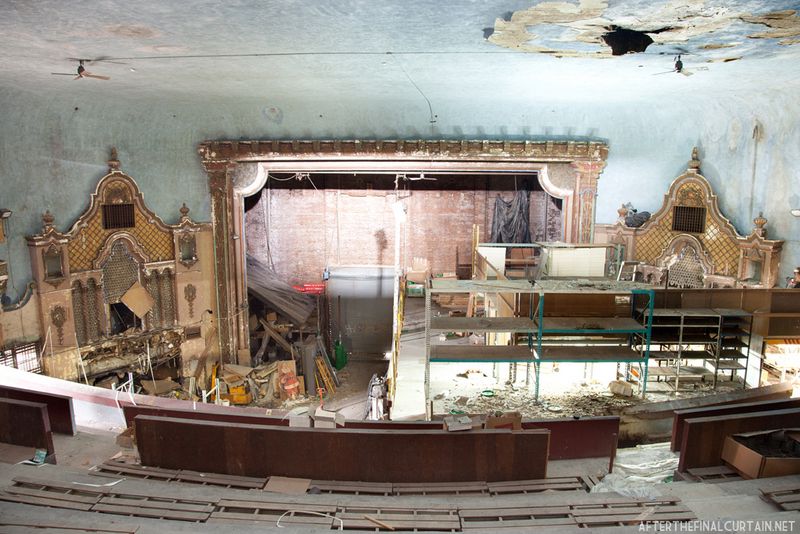
Image via After The Final Curtain
This 1,722-seat theatre opened on August 1, 1912 as the Broadway Theatre. First showing plays and vaudeville acts, it eventually segued into showing only films. One of the first films it showed was “Birth of A Nation,” a controversial film that’s credited as the inspiration for the reformation of the Klu Klux Klan.
The Broadway had a very similar history to the Paramount Theatre that came previously on this list. In 1930, management switched over to Paramount-Publix where it was remodeled in the atmospheric style. It is so similar, in fact, to the Newark Paramount Theatre that this Broadway Theatre was renamed the Paramount as well. But to avoid any confusion in this section, we’ll stick to calling it the Broadway Theatre.
Because of poor ticket sales, the Broadway closed on September 14, 1959. After being sold, it became used as a warehouse for Siperstein’s Paint until 2005 where there were some plans being made to convert the Broadway back into 1,800 seat theatre. However, those plans never seemed to make it off the drawing board since it’s still sitting abandoned in Long Branch, New Jersey
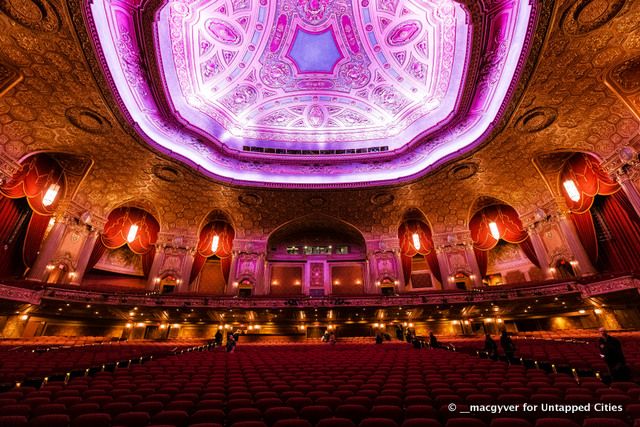
As one of the five Loew’s Wonder theatres in New York City, the 3,767-seat Kings Theatre in Brooklyn opened on September 7, 1929. Designed by the architectural firm Rapp & Rapp, it was decorated by Harold W. Rambush. The theatre was a Loew operated movie theater until 1977 when they sold it due to low attendance and high maintenance costs.
Because the theatre has such a hard time generating large audiences, many of the big ’70s blockbusters like Jaws, and Star Wars weren’t screened there. Instead it played mostly kung-fu movies and B-horror movies. Despite this, the theatre actually introduced some individuals who would eventually become famous actors, into the film industry. Many celebrities like Sylvester Stallone and Henry Winkler started out as ushers here.
In 1979 it was sold again, but then seized by the city for back taxes owed by the company that purchased it. Ultimately, the Kings Theatre slipped into disrepair like all the others on this list, the only difference being that there was actually a successful renovation project. The New York City Economic Development Corporation announced a $70 million renovation project in partnership with the ACE Theatrical Group of Houston, and in 2015 the successfully restored the Kings Theatre into a once again thriving theatre.
Untapped Cities was one of the first organizations to offer a tour of the renovated Kings Theatre, in partnership with the New York City Economic Development Corporation in 2015. See photos here.
Next, discover the 5 Loew’s Wonder Theatres in NYC and NJ and learn about the top 10 secrets of the Brooklyn Kings Theatre. Also, be sure to see the 9 unique movie theaters you’ll only find in NYC and the abandoned Amato Opera House in the East Village.
Subscribe to our newsletter